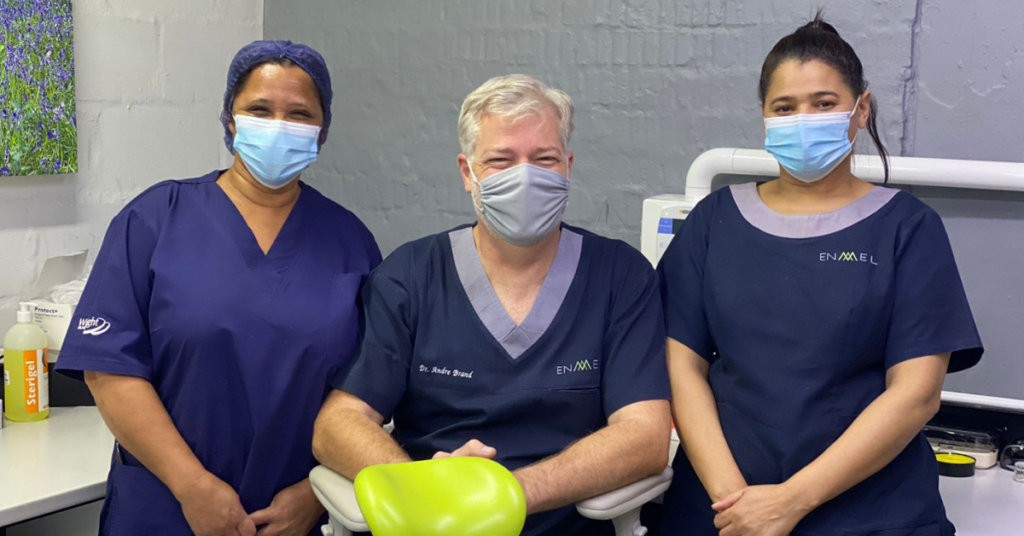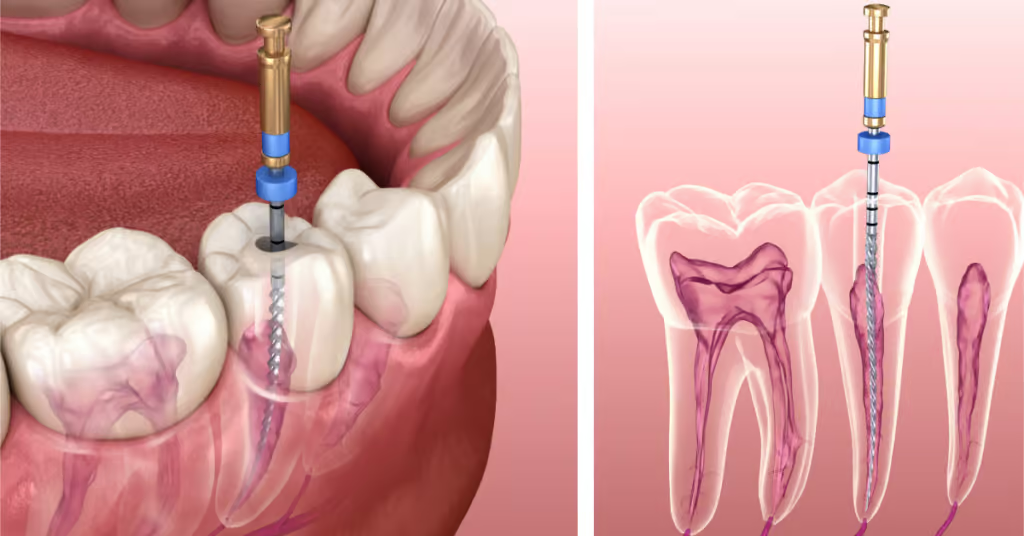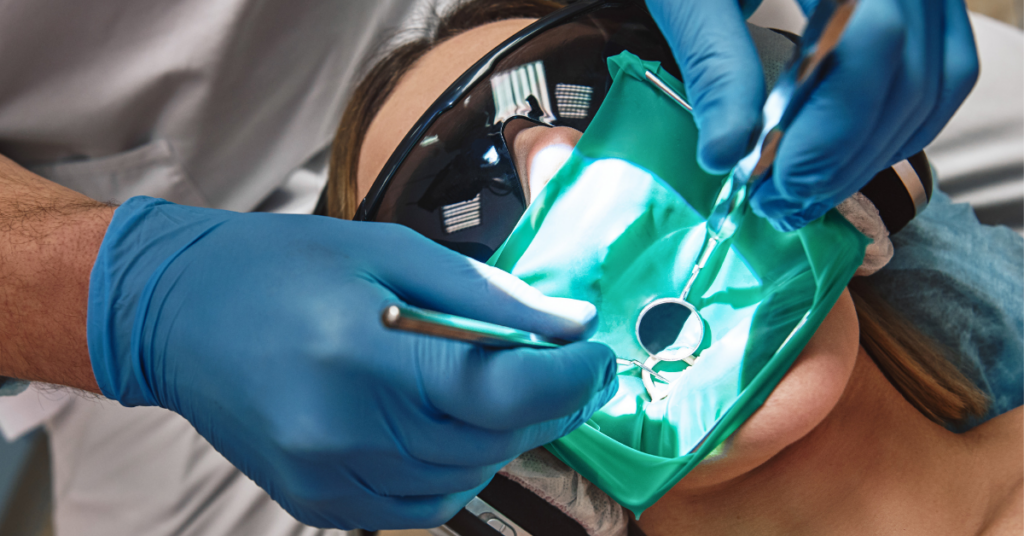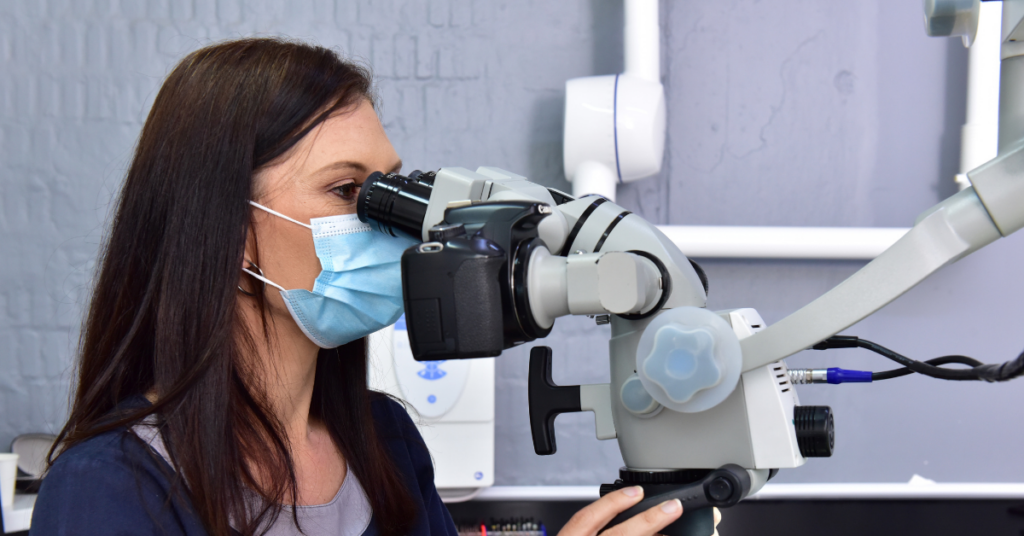A root canal treatment is when the soft center (pulp) of a tooth is removed. This pulp consists out of nerves, connective tissue, and blood vessels to ensure the tooth vital.

Why would I need a root canal treatment?
You will need a root canal treatment when:
- You have a tooth that is badly decayed.
- If the decay extends into the soft centre of the tooth or pulp.
- If your tooth develops a dental abscess due to tooth decay or trauma experienced.
To help you with your decision making process, we answer frequently asked questions about root canals:
Why do I need a CBCT scan if my referring dentist has already taken a small x-ray (peri-apical x-ray) of the specific tooth?
When a patient presents with a tooth-related pain or swelling, the first line of radiograph is often a peri-apical or panoramic x-ray.
Downsides of peri-apical or panoramic x-rays include:
- They may or may not show abnormalities associated with an existing infection.
- Limitations in terms of diagnosing odontogenic infections or other forms of pathology.
- Although these X-ray’s provide 2 D impressions, they generate flat images might cause finer details to get lost.
At the moment, the only true dependable radiographic technique for accurate and early diagnosis is a CBCT.

Is root treatment expensive?
Not all teeth have the same amount of roots or canals inside their roots. Therefore, the price for a root treatment on an anterior tooth will be different from the price of a root treatment to be done on a molar tooth.
We believe that a root treatment is a way of saving your tooth. If you compare a tooth extraction with a replacement with either an implant or bridge, the treatment will be less expensive and most probably the better treatment option.

Why do you make use of Rubber dam? My previous dentist did root canal treatment on my tooth and didn’t use a dam.
A Rubber dam, also known as a dental dam, is a thin square sheet that we use to isolate the operative site from the rest of the mouth.
Benefits of a rubber dam include:
- Prevents saliva from interfering with the dental treatment
- Preventing contamination and the infiltration of oral microorganisms into the operating field during root canal treatment
- Prevents filling material and irrigation liquid to cause irritation or obstruction in the throat
- Keeps the operating area dry and saliva-free.
- Protects the patient from any harmful situations.

How is an apex-locator able to measure my root lengths?
We make use of an electric apex locator which uses an electrical circuit through the root canal and oral soft tissue to determine the location of the opening at the tip of the root.
The electrical circuit is completed once we insert the instrument into the root canal. We do this, by inserting the locator facing an apical direction which will then cause it to touch the surrounding tissue around the tooth.
Is a dental operating microscope necessary to do root canal treatments?
You can best treat that what you can see.
Working in a patient’s mouth you are making use of a dental mirror and optics to see what is happening in and around a tooth or tooth structure. The naked eye can only see so much. We enhance the performance with optic loupes to help our endodontist see better.
Presently, we have a dental operating microscope (DOM) that helps to enhance an image up to 20 times. This makes it easier for us to look for tooth canals to make sure they appear clean. When we have to treat a patient again, by removing filling material, we use the microscope to provide us with actual visualisation.

What is the use of lasers in root canal treatment?
We use lasers for the following reasons:
- It is used together with a chemical debridement to remove dental pulp tissue and organic debris from the root canals inside the tooth.
- It helps us to shape and clean the dentinal walls.
- We use it to ensure that all areas have been thoroughly disinfected before sealing the canals with a permanent sealer and filler material.
Do all root-treated teeth need crowns?
Not all root-treated teeth need crowns. The reasons why one would need a crown is:
- Your tooth has lost a lot of its tooth structure.
- A specific tooth is badly broken
- A tooth that takes a lot of impacts (bottom and top molar teeth and also top premolars) should be crowned.
If a tooth needed root treatment due to access formation on a tooth caused by trauma and no tooth structure was lost prior to access formation, then the tooth in most circumstances will be okay without crown placement.
What to expect after treatment?
Here is a list of things you might experience after treatment, including handy tips:
- The tooth and gums might be sore after the local anaesthetic wears off.
- The gums can sometimes show signs of swelling. We can treat the symptoms with over-the-counter pain medication.
- Do call your dentist if the pain becomes more extreme or lasts for longer than a few days.
- We would recommend that you avoid chewing on the specific tooth. This is needed until your crown has been permanently placed or if the tooth has been permanently filled.
Our team will set up a follow-up appointment to ensure healing and health in and around the tooth is maintained.
For any questions or to book a consult please phone or WhatsApp and make an appointment. We will gladly assist where we can.

